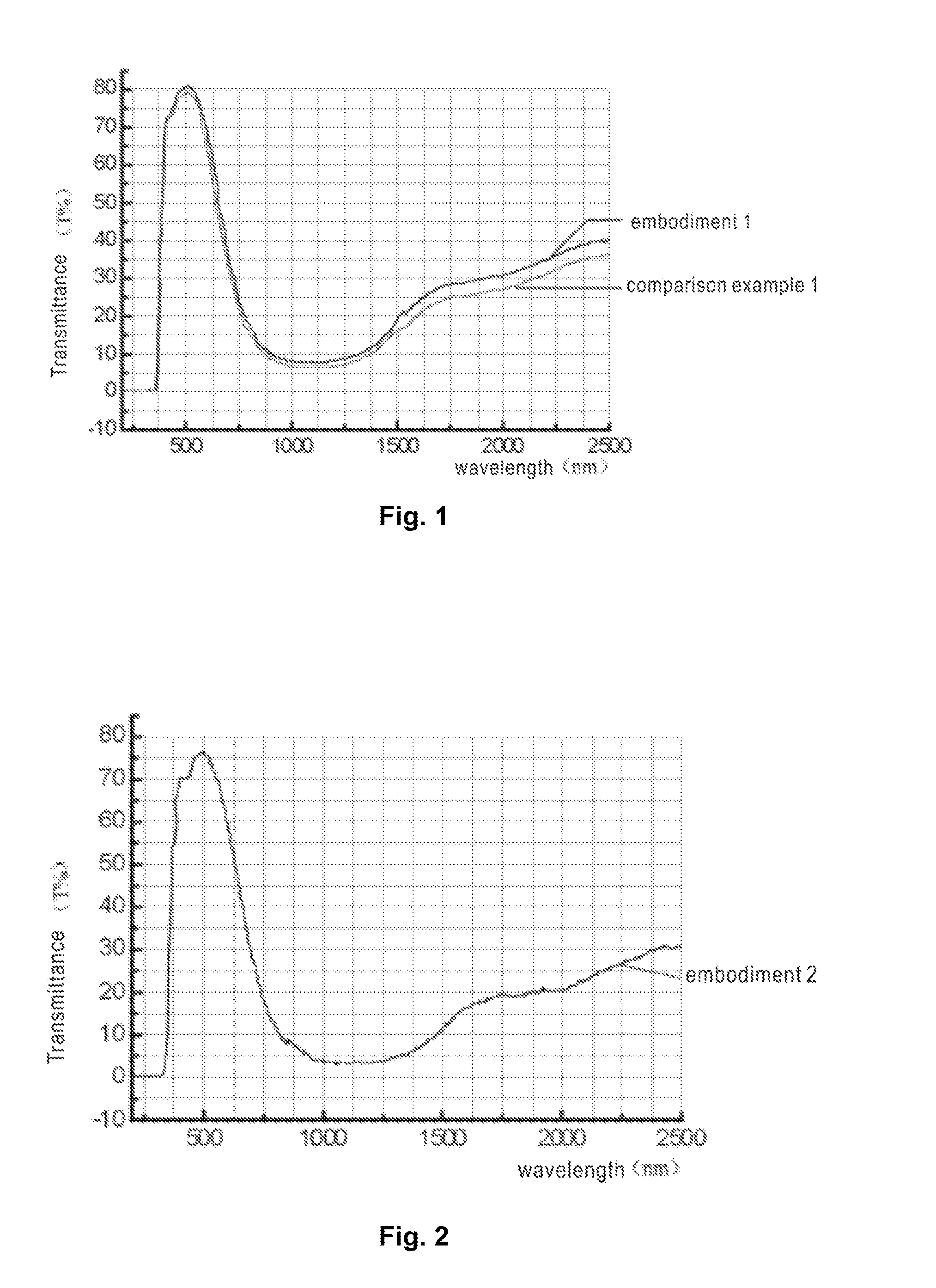Ultraviolet ray and infrared ray-absorbing glass composition and application thereof
a technology of infrared rays and glass, applied in the field of ultraviolet ray and infrared ray-absorbing glass composition, can solve the problems of inability to realize ideal glass with super heat absorption, inability to absorb infrared rays, and difficulty in shaping process, so as to reduce visual fatigue, reduce glare effect, and avoid spontaneous glass rupture
- Summary
- Abstract
- Description
- Claims
- Application Information
AI Technical Summary
Benefits of technology
Problems solved by technology
Method used
Image
Examples
embodiment 1
[0061]Taking the preparation of a 2 mm thick light blue green glass composition for example, in a 2000° C.-resistant zirconium oxide crucible, add the following raw material components: 500 g of quartz sand, 5 g of potassium feldspar, 30 g of limestone, 160 g of dolomite, 200 g of sodium carbonate, 4 g of boric oxide, 6 g of fluorite, 6 g of mirabilite, 1 g of carbon powder, and an ultraviolet ray and infrared ray-absorbing glass main body coloring and coordinating part in an amount as required.
[0062]Uniformly mix the raw materials; add 1 g of a reducing agent carbon powder to control the oxidation-reduction ratio; control the melting temperature at 1500 degrees centigrade to 1550 degrees centigrade for about 30 minutes; heat to 1500 degrees centigrade, maintain for about 30 minutes, then heat to 1530 degrees centigrade, then perform clarification and homogenization, reduce the clarification temperature from 1450 degrees centigrade to 1300 degrees centigrade for about 30 minutes, fi...
embodiment 2
[0065]Taking the preparation of a 4 mm thick blue green glass composition for example, in a 2000° C.-resistant zirconium oxide crucible, add the following raw material components: 530 g of quartz sand, 8 g of potassium feldspar, 20 g of limestone, 155 g of dolomite, 190 g of sodium carbonate, 3 g of boric oxide, 5 g of fluorite, 6 g of mirabilite, 1 g of carbon powder, and an ultraviolet ray and infrared ray-absorbing glass main body coloring and coordinating part in an amount as required. The preparation method of the glass composition is as described above and will not be repeated.
[0066]Components for obtaining the glass composition are as follows:
TABLE 5Glass component of glass composition at 4 mmComponentComparison(weight ratio %)Embodiment 2example 21SiO267.7369.32Na2O10.0610.93Al2O32.61.884K2O3.9723.5395CaO8.4858.1096MgO3.8193.6957BaO1.131.38F0.450.39Br—0.491410Fe2O30.7360.834211SO30.0190.02312TiO20.0190.099313Cl0.0210.03414MnO0.0090.00815CuO0.0070.00616ZrO2 + HfO20.12020.1517...
embodiment 3
[0068]Taking the preparation of a 5 mm thick blue green glass composition for example, in a 2000° C.-resistant zirconium oxide crucible, add the following raw material components: 550 g of quartz sand, 6 g of potassium feldspar, 15 g of limestone, 160 g of dolomite, 195 g of sodium carbonate, 3 g of boric oxide, 5 g of fluorite, 6 g of mirabilite, 1 g of carbon powder, and an ultraviolet ray and infrared ray-absorbing glass main body coloring and coordinating part in an amount as required. The preparation method of the glass composition is as described above and will not be repeated.
[0069]Components for obtaining the glass composition are as follows:
TABLE 8Glass component of glass composition at 5 mmComponent(weight ratio %)Embodiment 31SiO268.52Na2O11.53Al2O32.14K2O4.55CaO9.356MgO4.57BaO2.28Br0.879Fe2O30.71610SO30.0211TiO20.212Cl0.03213MnO0.00914CuO0.00715ZrO2 + HfO20.01516SrO0.008517CeO20.4918B2O30.1519WO30.001%20P2O50.03%21Sb2O30.05%
TABLE 9Oxidation reduction parameters glass com...
PUM
| Property | Measurement | Unit |
|---|---|---|
| thickness | aaaaa | aaaaa |
| thickness | aaaaa | aaaaa |
| thickness | aaaaa | aaaaa |
Abstract
Description
Claims
Application Information
 Login to View More
Login to View More - R&D
- Intellectual Property
- Life Sciences
- Materials
- Tech Scout
- Unparalleled Data Quality
- Higher Quality Content
- 60% Fewer Hallucinations
Browse by: Latest US Patents, China's latest patents, Technical Efficacy Thesaurus, Application Domain, Technology Topic, Popular Technical Reports.
© 2025 PatSnap. All rights reserved.Legal|Privacy policy|Modern Slavery Act Transparency Statement|Sitemap|About US| Contact US: help@patsnap.com



